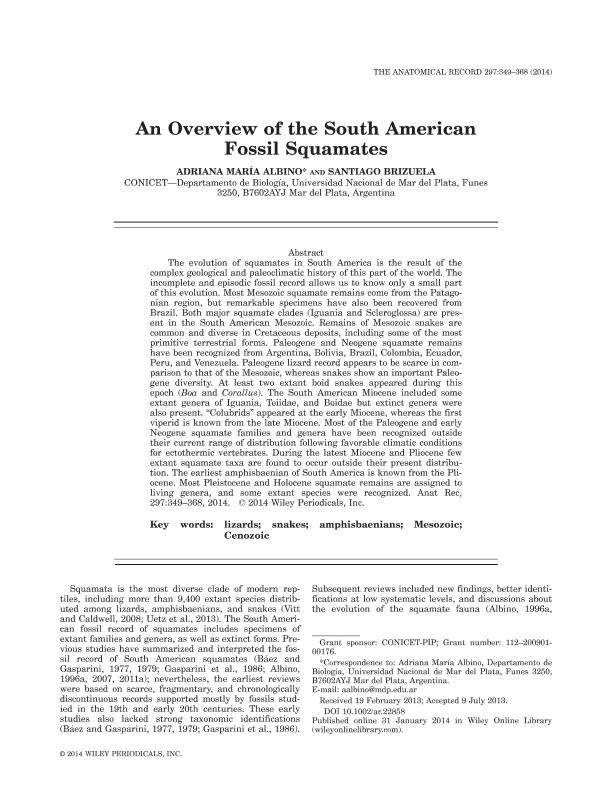Mostrar el registro sencillo del ítem
dc.contributor.author
Albino, Adriana Maria

dc.contributor.author
Brizuela, Santiago

dc.date.available
2017-09-27T18:04:01Z
dc.date.issued
2014-03
dc.identifier.citation
Albino, Adriana Maria; Brizuela, Santiago; An Overview of the South American Fossil Squamates; Veterinary and Human Toxicology; Anatomical Record-Advances in Integrative Anatomy and Evolutionary Biology; 297; 3; 3-2014; 349-368
dc.identifier.issn
1932-8486
dc.identifier.uri
http://hdl.handle.net/11336/25228
dc.description.abstract
The evolution of squamates in South America is the result of the complex geological and paleoclimatic history of this part of the world. The incomplete and episodic fossil record allows us to know only a small part of this evolution. Most Mesozoic squamate remains come from the Patagonian region, but remarkable specimens have also been recovered from Brazil. Both major squamate clades (Iguania and Scleroglossa) are present in the South American Mesozoic. Remains of Mesozoic snakes are common and diverse in Cretaceous deposits, including some of the most primitive terrestrial forms. Paleogene and Neogene squamate remains have been recognized from Argentina, Bolivia, Brazil, Colombia, Ecuador, Peru, and Venezuela. Paleogene lizard record appears to be scarce in comparison to that of the Mesozoic, whereas snakes show an important Paleogene diversity. At least two extant boid snakes appeared during this epoch (Boa and Corallus). The South American Miocene included some extant genera of Iguania, Teiidae, and Boidae but extinct genera were also present. "Colubrids" appeared at the early Miocene, whereas the first viperid is known from the late Miocene. Most of the Paleogene and early Neogene squamate families and genera have been recognized outside their current range of distribution following favorable climatic conditions for ectothermic vertebrates. During the latest Miocene and Pliocene few extant squamate taxa are found to occur outside their present distribution. The earliest amphisbaenian of South America is known from the Pliocene. Most Pleistocene and Holocene squamate remains are assigned to living genera, and some extant species were recognized.
dc.format
application/pdf
dc.language.iso
eng
dc.publisher
Veterinary and Human Toxicology

dc.rights
info:eu-repo/semantics/openAccess
dc.rights.uri
https://creativecommons.org/licenses/by-nc-sa/2.5/ar/
dc.subject
AMPHISBAENIANS
dc.subject
CENOZOIC
dc.subject
LIZARDS
dc.subject
MESOZOIC
dc.subject
SNAKES
dc.subject.classification
Oceanografía, Hidrología, Recursos Hídricos

dc.subject.classification
Ciencias de la Tierra y relacionadas con el Medio Ambiente

dc.subject.classification
CIENCIAS NATURALES Y EXACTAS

dc.title
An Overview of the South American Fossil Squamates
dc.type
info:eu-repo/semantics/article
dc.type
info:ar-repo/semantics/artículo
dc.type
info:eu-repo/semantics/publishedVersion
dc.date.updated
2017-09-25T17:59:18Z
dc.identifier.eissn
1932-8494
dc.journal.volume
297
dc.journal.number
3
dc.journal.pagination
349-368
dc.journal.pais
Estados Unidos

dc.journal.ciudad
Hoboken
dc.description.fil
Fil: Albino, Adriana Maria. Universidad Nacional de Mar del Plata; Argentina. Consejo Nacional de Investigaciones Científicas y Técnicas. Centro Científico Tecnológico Conicet - Mar del Plata; Argentina
dc.description.fil
Fil: Brizuela, Santiago. Consejo Nacional de Investigaciones Científicas y Técnicas. Centro Científico Tecnológico Conicet - Mar del Plata; Argentina. Universidad Nacional de Mar del Plata; Argentina
dc.journal.title
Anatomical Record-Advances in Integrative Anatomy and Evolutionary Biology

dc.relation.alternativeid
info:eu-repo/semantics/altIdentifier/doi/http://dx.doi.org/10.1002/ar.22858
dc.relation.alternativeid
info:eu-repo/semantics/altIdentifier/url/http://onlinelibrary.wiley.com/doi/10.1002/ar.22858/abstract
Archivos asociados
